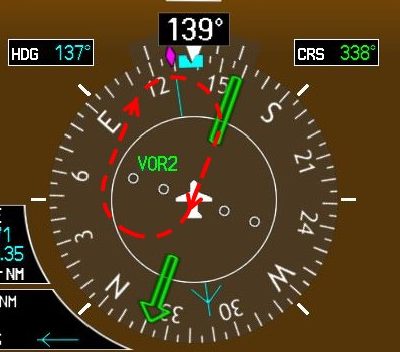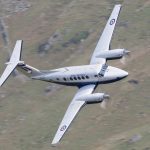Sector Two (Offset) Join
This join is maybe the easiest of all and should perhaps be chosen rather than a Parallel join if your Magnetic Heading is within the +/- 5° tolerance between Sectors One and Two.
Example – Joining the Oxford RW19 Hold, Wind 240/20kts. When cleared to join the hold, it is most important to set the Course Pointer to track the inbound leg of the hold. Then, as you fly towards the beacon, you can visualise the holding pattern imposed onto the HSI as follows:

Imagine the Holding Fix, in this case the Oxford ADF, being at the centre of the HSI and remember to orientate the hold in the correct direction; the Oxford RW19 hold is a standard right-hand hold. Using this technique, you can quickly see that you are joining from Sector Two and need to carry out an Offset join by flying over the beacon and onto the holding side of the pattern towards the end of the outbound leg.
Start the timer as you fly over the beacon, turn to fly outbound with the tail of the Bearing Pointer offset (hence the name) from the tail of the Course Pointer by 30° (in still air) and remember to report “Callsign, joining the hold maintaining altitude xxxx feet”.

Notice in the snapshot above that, if you have passed directly over the beacon, the tail of the bearing pointer will settle quickly onto the Track Diamond. However, if you passed to one side of the beacon and fly with the Track Diamond on the outbound track you require, you will fly parallel to it and never actually achieve it. So you must drag the tail of the Bearing Pointer to the radial you require.
With a strong crosswind, it will be necessary to apply twice the drift when flying outbound to compensate for the effect of wind in the inbound turn. So in this example (wind 240°/20 kts), the outbound heading should be 148° to stabilise the tail of the Bearing pointer on 138°.
After one minute (corrected for wind) start the turn onto the inbound leg and be ready to use the Gate Two technique (described on the Maintaining the Hold page) to ensure that you quickly stabilise on the inbound track.















